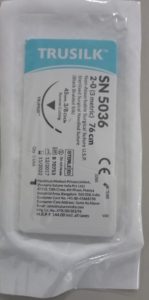The silk suture is a non-absorbable/braided material. The suture material composed of an organic protein called fibroin. Specialized protein derived from the species of family Bombycidae called Fibroin . The cocoon of silkworm larvae
The suture is coated with wax which helps in lubrication and avoids erosion of tissue.
Silk Suture-Uses
Natural material and used almost in all the department of surgical departments and in anesthesia.
In anesthesia, this suture is used in fixation of the central venous catheter (CVP), Femoral catheter, dialysis catheter, etc.
Used in the closure of skin and subcutaneous tissue most of the surgery. In some cases, the suture is replaced by the
Surgical skin stapler, 2 octyl cyanoacrylate solution, etc.
Types of silk sutures
Silk is available in dyed and undyed silk sutures.
Plain silk suture non-absorbable suture and braided suture. Biological/natural suture derived from the cocoon of the silkworm larva.
Coated with wax to reduce capillary action of the braided suture
Knot security is good and low cost
Tissue reaction not good compared to other suture-like monocryl or Nylon suture

Suture with dyed (blue in color) – Methylene blue
Silk suture without dyed (black)- Hematein HCK
The suture is available in different types like gauges, sizes and in lengths, etc.
The suture has impinged into the stainless steel needle.
Mer-silk same like other silk used in ligating the bleeder and for anastomosis
Mer-silk a non-absorbable suture and braided
The needles are coming in different types
- Cutting type needle
- Taper cut needle
- Round body needle
- Reverse cutting etc.
Silk suture Indication
Used for the approximation of soft tissue and in ligation of tissue in abdominal surgery, cardiovascular surgery, ophthalmology surgery, and neurosurgery.
The suture selected for particular patients, tissue conditions, surgical techniques, and wound sizes, etc.
Silk suture elicits an initial inflammatory reaction in tissue and fibrous connective tissue enhances the encapsulation of suture.
Contraindication
Allergy to the skin
Sensitivity to the silk suture
Recommended to permanent retention of tensile strength
Sterilization of the suture before packing must be done with the either Ethylene oxide sterilization or Irradiation methods
Once it opened, don’t desterilize the suture and store it in 25-degree centigrade
Keep away from moisture, fluid, and overheat.
The main drawback of the suture includes
Coating reduced knot security
Incites tissue reaction
Infection
Capillarity
Complications such as infection and sinus formation